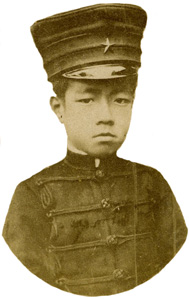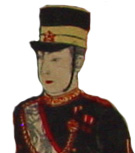Prints of Emperor Meiji, Empress Shōken
and the Royal Family
Introducing the Emperor and His Family to the People
Prints in Collection Portraying the Royal Family
click on any image for details
| Mirror of Our Country’s Revered Deities and Esteemed Emperors, 1878 (Emperor Meiji and Empress Shōken surrounded by their imperial lineage) Yōshū Chikanobu (1838-1912) IHL Cat. #455 |
 (The emperor is entertained in Kyoto by plays organized by Princess Sumiko) IHL Cat. #1943 | (Emperor Meiji and an entourage of court ladies on the Phoenix boat viewing the cherry trees along Tokyo's Sumida River) Yōshū Chikanobu (1838-1912) IHL Cat. #2248 |
| (The emperor and empress at the races) Sekisai Kuniyasu (active 1880–1890s) IHL Cat. #473 | Illustration of Celebration Banquet at the New Imperial Palace, 1885 (New Year's greetings are given to the emperor by the prime minister in the temporary Akasaka Detached Palace) Sekisai Kuniyasu (active 1880–1890s) IHL Cat. #2284 |
Famous Places, Azuma Bridge in Asakusa, Tokyo, 1888
(The emperor and empress at the opening of Japan's first metal bridge in
December 1877)
Utagawa Kunimasa IV (1848-1920)
IHL Cat. #446
| (Minister Sanetomi reads a proclamation regarding the constitution to the emperor in his throne room on February 11, 1889) IHL Cat. #1104 | Illustration of [The Emperor’s Carriage] Departing the Imperial Palace [over] Nijūbashi, March, 1889 (After the promulgation of the constitution ceremony in the palace the emperor, empress and their procession head for the Aoyama military parade field) | Illustration of the Imperial Procession through the Streets after the Ceremony of the Promulgation of the Constitution, February 6, 1889 (After the promulgation of the constitution ceremony the emperor and empress and their procession head for the Aoyama military parade field) Yōshū Chikanobu (1838-1912) IHL Cat. #2092 |
Illustration of the Emperor and Empress Arriving at the Third National Industrial Exhibition, 1890
(The emperor and empress each arrive
in a royal carriage at the opening ceremonies of the
3rd National Industrial Exhibition)
Kojima Shōgetsu (active 1870–1900)
IHL Cat. #79
(The emperor attends a meeting of the House of Peers) IHL Cat. #1515 | Illustration of Emperor at National Diet Building, 1890 (The emperor arrives at the First Temporary Diet building) Kojima Shōgetsu (active 1870–1900) IHL Cat. #351 | (The emperor arrives at the First Temporary Diet building) IHL Cat. #1174 |
A List of the House of Representatives, 1891
(The emperor and empress are shown in cameo flanking the interior of the
First Temporary Diet Building)
Nagashima Shungyō (active 1882-1905)
IHL Cat. #303
Illustration of the Silver Wedding Anniversary Celebration, March 1894 (The emperor and empress receive felicitations on their 25th wedding anniversary) Hasegawa Chikuyō (fl. c. 1870-1890s) IHL Cat. #2285 | Illustration of the Silver Wedding Celebration, March 1894 (The emperor and empress, with the crown prince in attendance, receive felicitations on their 25th wedding anniversary) Utagawa (Shunsai) Toshimasa (?-1913) IHL Cat. #2074 |  (The emperor and empress [off-stage] receive felicitations on their 25th wedding anniversary) Yōshū Chikanobu (1838-1912) IHL Cat. #383 |
Emperor and Empress Leaving the Palace after the Silver Wedding Anniversary, March 1894
(The emperor and empress departing the palace for the public ceremony at the Aoyama parade grounds)
Hasegawa Chikuyō (fl. c. 1870-1890s)
IHL Cat. #2287
Illustration of a Visit by the Empress to the General Staff Headquarters, 1895 (The empress presents a general with a tray of rolled bandages for wounded soldiers) Kobayashi Kiyochika (1847-1915) IHL Cat. #443 | Hurrah for the Empire! Illustration of His Majesty, the Commander-in-chief, Welcoming [military officers] to the Imperial Palace with the Emperor’s Gift Cup, 1895 Watanabe Nobukazu (1872-1944) IHL Cat. #300 | Sino-Japanese Peace: The Whole Nation Praises Imperial Virtue, 1895 (Emperor Meiji and 5 year old Crown Prince Yoshito, with Empress Shōken in the background celebrate victory in the Sino-Japanese War) Watanabe Nobukazu (1872-1944) IHL Cat. #160 |
True Depiction of Citizens Greeting the Carriage of His Imperial Majesty and Commander-in-Chief upon His Return through the Triumphal Arch, July 1895 (Emperor Meiji's procession through the Hibiya Triumphal Arch in Tokyo after his return from Kyoto on May 30, 1895) Ogata Gekkō (1859-1920) IHL Cat. #192 | Illustration of Citizens Greeting the Return of His Imperial Majesty's Carriage, May 1895 (Emperor Meiji's procession through the Hibiya Triumphal Arch in Tokyo after his return from Kyoto on May 30, 1895) Yūsai Toshiaki (1864-1921) IHL Cat. #2286 | Illustration of Our Army’s Triumphal Return and Distinguished Service Awards, 1895 (In this print an army officer receives an award from the emperor. Some 2000 awards were given to both military personnel and civilians for their service and sacrifice during the war. ) Utagawa Kokunimasa (1874-1944) IHL Cat. #2283 |
| Imperial Prosperity: Ceremony in the Eastern Capital, 1900 (introducing the public to the May 10, 1900 ceremonies surrounding the wedding of Crown Prince Yoshihito to Kujō Sadako) Watanabe Nobukazu (1872-1944) IHL Cat. #222 | Illustration of Noble's Imperial Ceremony, 1900 (introducing the public to the May 10, 1900 ceremonies surrounding the wedding of Crown Prince Yoshihito to Kujō Sadako) Watanabe Nobukazu (1872-1944) IHL Cat. #1100 | (introducing the public to the May 10, 1900 ceremonies surrounding the wedding of Crown Prince Yoshihito to Kujō Sadako) Watanabe Nobukazu (1872-1944) IHL Cat. #1327 |
| (Two carriages depart the imperial palace, the first with unseen occupants, the second with Crown Prince Yoshito and his bride-to-be Kujō Sadako) Watanabe Nobukazu (1872-1944) IHL Cat. #259 | (The emperor and empress arrive at a general meeting of the Japanese Red Cross in Ueno Parik) Watanabe Nobukazu (1872-1944) IHL Cat. #609 | (The emperor and empress arrive in Ueno Park. "The people stood face to face before the Emperor! Well might old folks shed tears at this extraordinary privilege! Ceremony being ended, the Emperor returned to his palace amidst the loud acclamation of 'Banzai, Banzai'.") IHL Cat. #901 |
Funerals of the Empress Dowager and Emperor Meiji
Empress Dowager Eishō’s Imperial Funeral,
February 5, 1897
(A announcement of the Empress Dowager's death and funeral)
Harada Kōkyo (1863-1925)
IHL Cat. #1809
Illustration of the Main Gate at Aoyama
During the Imperial Funeral Ceremony, 1912
(Picturing the September 13, 1912 evening funeral procession for Emperor Meiji from the Imperial Palace to the Aoyama military parade grounds.)
Hanpo (active 1904-1912)
IHL Cat. #1683Illustration of His Imperial Majesty's Funeral
Outside Nijūbashi, 1912
(The funeral session was enormous in scale, involving more than 20,000 people. It began at 8:00 p.m. with the departure from the palace grounds through the main gate at Nijūbashi.)
Hanpo (active 1904-1912)
IHL Cat. #2214
Portraying the Emperor and Empress
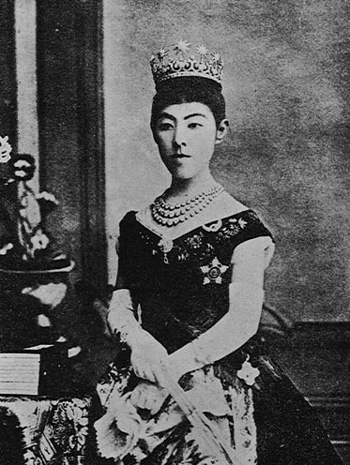 | 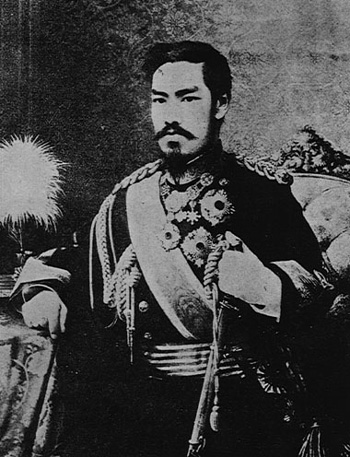 |
Source: Japan Awakens: Woodblock Prints of the Meiji Period (1868-1912), Barry Till, Pomegranate Communications, Inc., 2008, p. 34-36.
In the 1870s, about a decade into the Meiji period (1863-1912), Emperor Meiji (1852-1912) and Empress Haruko [Shōken] (1849-1914) became popular subjects for woodblock artists. This was a break with tradition, as under shogunate rule, some subjects, including depictions of the imperial couple, were off limits to artists.
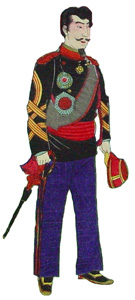 | In the woodblock portrayals, the emperor was almost always depicted wearing a Western uniform bedecked with medals and gold braid; sometimes a Western military cap; and, invariably, Western-style whiskers and haircut. In 1886, the empress began wearing Western dresses with ruffles, cinched waists, and trains and the following year brought a proclamation urging Japanese women to follow her example. The emperor and empress appear very approachable and personable. Meiji is often depicted at ceremonies and events, such as the inauguration of the railway and the signing of the constitution; or presiding over parliament, greeting foreign dignitaries, opening various expositions, celebrating the twenty-fifth anniversary of his marriage, or simply strolling in a park. The emperor was frequently portrayed overseeing military maneuvers as the supreme commander; the empress, visiting wounded soldiers in military hospitals. Both figures appear in wartime prints, rallying public enthusiasm. Occasionally the young heir apparent, the crown prince, was portrayed with his parents. | 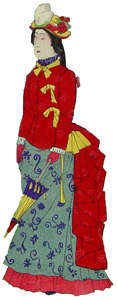 |
The Emperor and Empress - An Overview
Source: Canadian Heritage Information Network website http://agora.museevirtuel.ca/edu/ViewLoitLo.do;jsessionid=A6D91E974BCBE59D18176D1CA9FF6468?method=preview&lang=EN&id=12984In 1867, after the death of the Emperor Komei, the throne was passed to his son, Mutsuhito, who became known posthumously as Emperor Meiji, meaning "Enlightened Ruler." During the Tokugawa period (1603-1868 and also known as the Edo period), the emperor, considered by the Japanese to be a divine ruler, was a ceremonial head of state, divested of political power. All administrative and military functions were governed by the shoguns, who had been appointed by the emperor. However, in 1869 the young emperor’s position changed dramatically when he moved from Kyoto to Tokyo, the new capital, and supported the government’s efforts to centralize power and modernize the nation. Allowing his ministers to govern affairs of state, the emperor concentrated on becoming a symbol of modernization. Through his example, he guided the Japanese to accept the rapid changes in their society. He led the way to modernization in 1872 by cutting his topknot, preferring a Western hairstyle and mustache, and wearing Western clothing for official appearances.
Haru-ko, the wife of the Meiji Emperor, was the daughter of a high noble of the court of Kyoto. Like the emperor, she, too, broke with tradition and became a symbol of modernity. In 1873, she abandoned the traditional custom for married women to shave their eyebrows and blacken their teeth. The empress became involved in the war effort during the Sino-Japanese and Russo-Japanese wars, frequently visiting the military hospitals. Committed to the education of young Japanese women, she encouraged them to keep up with the changes in fashion and manners that were affecting Japanese society. She founded the Red Cross Hospital at Shibuya in Tokyo, and she devoted a great deal of time to a variety of charitable causes. In 1886, it was decided that the empress should wear Western-style dresses for public occasions, and on January 17, 1887 an official proclamation urged all women to follow her example. However, like most Japanese, both the emperor and his wife wore traditional garments when in private.
The Crown Prince (1879-1926)
1 Emperor of Japan: Meiji and His World, 1852-1912, Donald Keene, Columbia University Press, 200, p. 211.
2 Japan at the Dawn of the Modern Age – WoodblockPrints from the Meiji Era, Louise E. Virgin, Donald Keene, et. al.,MFA Publications, 2001, p. 38.
3 It is reported that in 1882 print publishers received a warning about depicting the emperor in the company of consorts and that for a brief period depictions of "Their Sacred Imperial Majesties" were prohibited.
last revision:
6/13/2020
1/26/2020






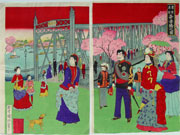

![Illustration of [The Emperor’s Carriage] Departing the Imperial Palace [over] Nijūbashi](../visual-index-of-prints-t---z/Departing the Imperial Palace-c8f4f3e6fe8605d5.jpg)





![Illustration of the [Emperor at the] National Diet Building](../artists/watanabe-nobukazu-1872-1944-/Nobukazu Picture of the Natio-caeff222c817323d.jpg)









![Illustration of Military Review Outside [Osaka] Castle from the portfolio Souvenir Drawings of Famous Sights of Keihan [Kyoto-Osaka]](../artists/hirose-harutaka-1870/Military Review Outside the C-88c082bada6b851c.jpg)










